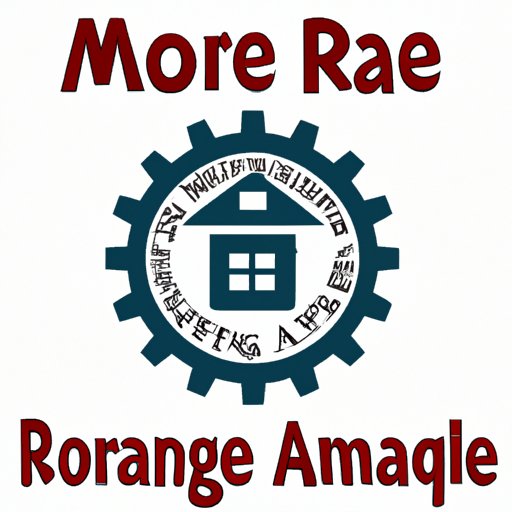Introduction
An adjustable-rate mortgage (ARM) is a type of home loan that carries a variable interest rate. Unlike a fixed-rate mortgage, which has a consistent interest rate over the life of the loan, the interest rate on an ARM can change periodically, depending on market conditions. This article will explore how an ARM mortgage works, highlighting its benefits and risks. It will also compare it to a fixed-rate mortgage and examine different types of ARM mortgages, as well as qualifying requirements.
Explaining the Basics of an ARM Mortgage
An adjustable-rate mortgage (ARM) is a type of mortgage loan with an interest rate that can adjust or “reset” periodically. The initial interest rate on an ARM is typically lower than a fixed-rate mortgage, but it can fluctuate throughout the life of the loan based on market conditions. An ARM loan usually comes with a “fixed period” of 3, 5, 7, or 10 years. During this period, the interest rate remains the same. After the fixed period ends, the interest rate can adjust up or down, depending on the current market conditions.
The adjustable rate components of an ARM mortgage include the index, margin, and adjustment cap. The index is a benchmark interest rate used by lenders to determine the amount of your monthly payment. Common indexes include the London Interbank Offered Rate (LIBOR), the Cost of Funds Index (COFI), and the 11th District Cost of Funds Index (CODI). The margin is the lender’s profit margin added to the index to determine the interest rate. Adjustment caps limit the amount the interest rate can increase or decrease at each adjustment period.
Highlighting the Benefits and Risks of an ARM Mortgage
An adjustable-rate mortgage can be a good option for those who plan to stay in their home for a short period of time, as the initial interest rate is often lower than a fixed-rate mortgage. This means that borrowers may be able to qualify for a larger loan amount or lower monthly payments. Additionally, if interest rates drop during the fixed period, borrowers have the option to refinance into a lower-rate loan.
However, there are also some risks associated with an ARM mortgage. If interest rates rise after the fixed period ends, borrowers may end up paying more in interest than they would have with a fixed-rate loan. Additionally, if the housing market drops and the value of the home decreases, borrowers may find themselves “underwater” and unable to refinance.
Comparing an ARM to a Fixed-Rate Mortgage
When deciding between an ARM and a fixed-rate mortgage, it’s important to consider both the interest rate and the payment structure. With a fixed-rate mortgage, the interest rate remains the same over the life of the loan. This means that borrowers will always know exactly what their monthly payments will be. With an ARM, the interest rate can change periodically, so borrowers may end up paying more or less each month.
In terms of interest rates, an ARM typically starts off with a lower rate than a fixed-rate mortgage, but this isn’t always the case. It’s important to look at current market rates for both loans and compare them side-by-side to determine which one is best for you.

Analyzing Current Market Rates for ARM Mortgages
Interest rates for ARM mortgages are determined by a variety of factors, including the index, margin, and adjustment caps. Currently, the average interest rate for an ARM is about 3.4%, compared to 4% for a fixed-rate mortgage. However, these rates can vary significantly depending on the type of loan, the term length, and other factors.
It’s also important to keep in mind that interest rates can change over time. The Federal Reserve sets the federal funds rate, which affects the rates offered by banks. In addition, economic conditions and the housing market can influence interest rates.

Examining Different Types of ARM Mortgages
There are several different types of ARM mortgages available, including hybrid ARMs, interest-only ARMs, and reverse mortgages. Hybrid ARMs combine features of both a fixed-rate mortgage and an ARM. They usually start off with a fixed rate for a set period of time, then switch to an adjustable rate for the rest of the loan. Interest-only ARMs allow borrowers to pay just the interest for a set period of time, before transitioning to a fully amortizing loan. Reverse mortgages are designed for seniors and allow them to access the equity in their homes without having to make monthly payments.

Reviewing Qualifying Requirements for an ARM Mortgage
In order to qualify for an ARM mortgage, borrowers must meet certain requirements. These include a minimum credit score, a minimum down payment, and other financial requirements. Generally, borrowers must have a credit score of at least 620 in order to qualify for an ARM loan. The down payment requirements vary depending on the type of loan, but generally range from 3% to 20%. Additionally, borrowers must have sufficient income and assets to cover the cost of the loan.
Conclusion
An adjustable-rate mortgage can be a good option for those looking for a lower initial interest rate and monthly payments. However, it is important to understand the risks associated with an ARM, such as the potential for higher interest rates and payments in the future. It is also important to compare current market rates for both ARMs and fixed-rate mortgages, as well as to understand the various types of ARM mortgages available and the qualifying requirements. By understanding the basics of an ARM mortgage, borrowers can make an informed decision when choosing a home loan.
(Note: Is this article not meeting your expectations? Do you have knowledge or insights to share? Unlock new opportunities and expand your reach by joining our authors team. Click Registration to join us and share your expertise with our readers.)
